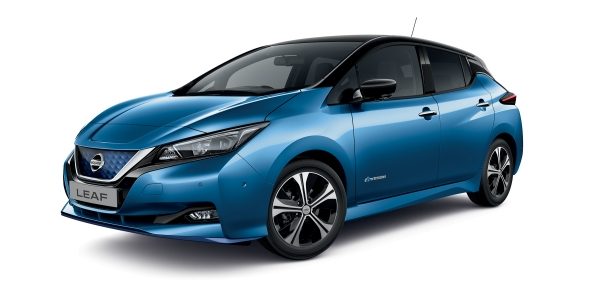
Tesla or Hummer? The answer may shock you: Sit down, buckle up, and get ready for a CO2 drag-race!
by Martin Harris
Pictured below is one of the most popular electric vehicles on the market, the Nissan Leaf. It is branded as “Zero Emissions”.

Pretty looking car by modern standards. And the owner can sleep easy, while their Leaf recharges, knowing they didn’t pump any of that nasty CO2 into the atmosphere.
But while EV owners dream, we at Uncensored sit awake at night crunching facts and figures. And those facts look rather grim for the trendy EV.
The basic model Nissan Leaf has a 30kWh battery.
For each kWh of storage capacity, between 150 and 200 kilograms of CO2 are generated during battery manufacture.
This equates to approximately 5 and a half tonnes of CO2 emissions before the car has even left the showroom floor.
That’s just for the battery, not including other vehicle manufacturing processes.
Let’s put that in perspective.
One could drive the average internal combustion powered vehicle for around three years before it matches the CO2 output of battery manufacture for the Leaf.
But Nissan’s Leaf is nothing compared to the Mighty Tesla, vehicle of choice for Greta Thunberg. Thunberg’s Tesla also doubles as a mobile repository for empty food containers and plastic bags.

The Tesla also happens to be the transport of choice for Greta’s friend Arnie. Arnie used to drive a big gas guzzling Hummer, but he’s a changed man now.

The Tesla Model S, with a 100kWh battery pack, is responsible for a staggering 17.5 tonnes of CO2 emission during manufacture. One would have to drive one’s Hummer for about 8 years to output that much CO2. Sorry Arnie, the Hummer would have been a greener choice.
Would you believe an all-electric Tesla Model S is considered a “high polluter” in Singapore? Owner Joe Nguyen spent months trying to get a license for his Tesla Model S so that it can be driven in Singapore, but he was in for a shock. The Singapore government requires that all imported used cars must undergo exhaust emissions and fuel efficiency tests, and in the case of the Model S, the car’s electricity generation process was assessed for carbon dioxide (CO2) emissions. Nguyen, who imported his vehicle from Hong Kong, was surprised to hear that the Tesla Model S was not given the Carbon Emissions-based Vehicle Scheme (CEVS) rebate of S$15,000 ($10,800) but rather he was charged a S$15,000 tax for having a non-fuel-efficient car instead because of the strain it puts on the electricity grid.
https://www.autoguide.com/auto-news/2016/03/tesla-model-s-categorized-as-a-high-polluter-in-singapore.html
EV proponents are no doubt ready to point out that once on the road, your EV becomes “Zero Emission”, while the gas guzzlers continue to pump out fumes. Look deeper.
As of 2018, there were approximately 2 million EVs on the road. Approximately 70% of those are still reliant on coal powered electricity generation for recharging. And unlike the author’s 1968 Volkswagen, which still has the original motor ticking along nicely after 52 years, an EV’s batteries deteriorate rapidly, requiring more and more frequent charging, with a claimed lifespan for the Leaf of between 8 and 10 years total. After which you’d better hope that recycling initiatives for your short-lived expendable EV are in place!
What about total vehicle manufacture from raw materials to finished vehicle? Comparing a Tesla Model 30 to an Internal combustion engine BMW 320i,the Beemer wins: 27.1 tonnes of CO2 for the Tesla vs 22.8 tonnes for the BMW.
But that’s not all. Pollution is not just about CO2. Some, including the author, do not believe CO2 is a concern at 400ppm current atmospheric concentration, bearing in mind plants thrive wonderfully in a greenhouse with 1200ppm of CO2. Despite the IPCC’s deceptive (and politically motivated) focus on CO2, there are greater environmental and humanitarian concerns to consider.
Oil and gas exploration and extraction are of course, fraught with environmental hazards: Oil spills, earthquakes (from fracking) and such horror stories as the Exxon Valdez spill and the BP Horizon explosion. Lets not be under any illusions. I’ve done my fair share of spirited protest against oil industry corruption and reckless extraction methods. But is there anything comparable in the rare earth mining and battery production industry?
Take a look at the nightmare images below. Toxic sludge-filled lakes, belching clouds of fumes, and great filthy open pits. And check out the happy, healthy, well-paid workers enjoying the benefits of zero emissions transportation, if you’ll pardon my sarcasm. Here’s the dirty secret of rare earth mining exposed, child labour, dead fishes and all.
Happy motoring.


FARN publish report on the impacts of lithium mining on human rights in Argentina.
IVL Svenka study on the environmental impact of Lithium -Ion batteries
Would You Believe a Tesla Model S Causes More Pollution than a BMW 3 Series?

Get your copy from our Online Store or your local book and magazine retailer
Australian Retail Locations » Uncensored Publications Limited
New Zealand Retail Locations » Uncensored Publications Limited
As censorship heats up and free thought becomes an increasingly rare commodity, we appeal to our readers to support our efforts to reach people with information now being censored elsewhere. In the last few years, Uncensored has itself been censored, removed from the shelves of two of our biggest NZ retailers – Countdown Supermarkets and Whitcoulls Bookstores – accounting for 74% of our total NZ sales.
You can help keep the Free Press alive by subscribing and/or gifting a subscription to your friends and relatives.








